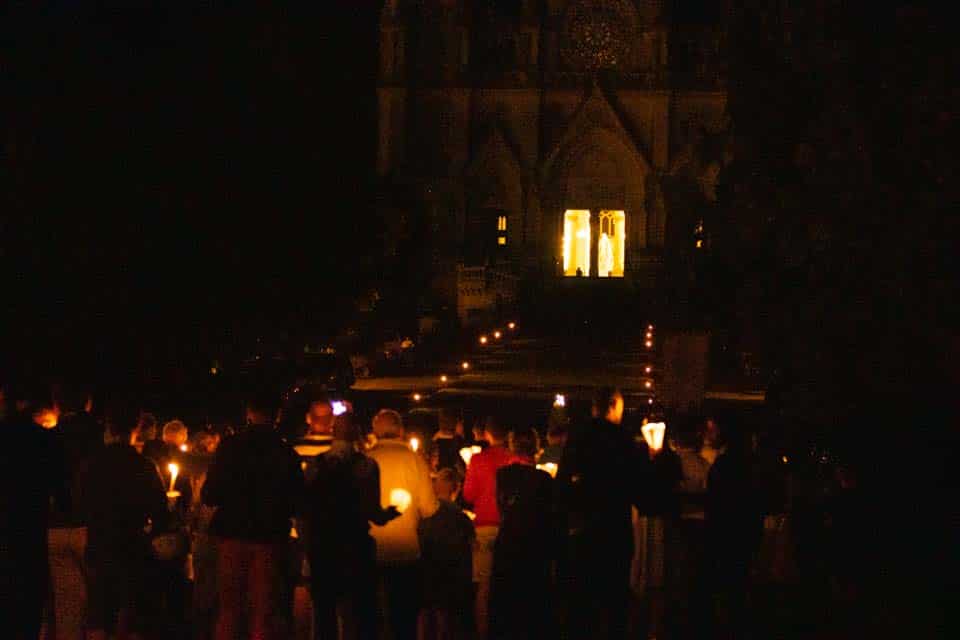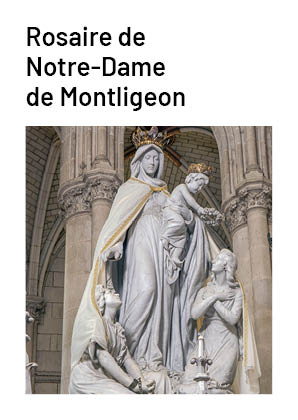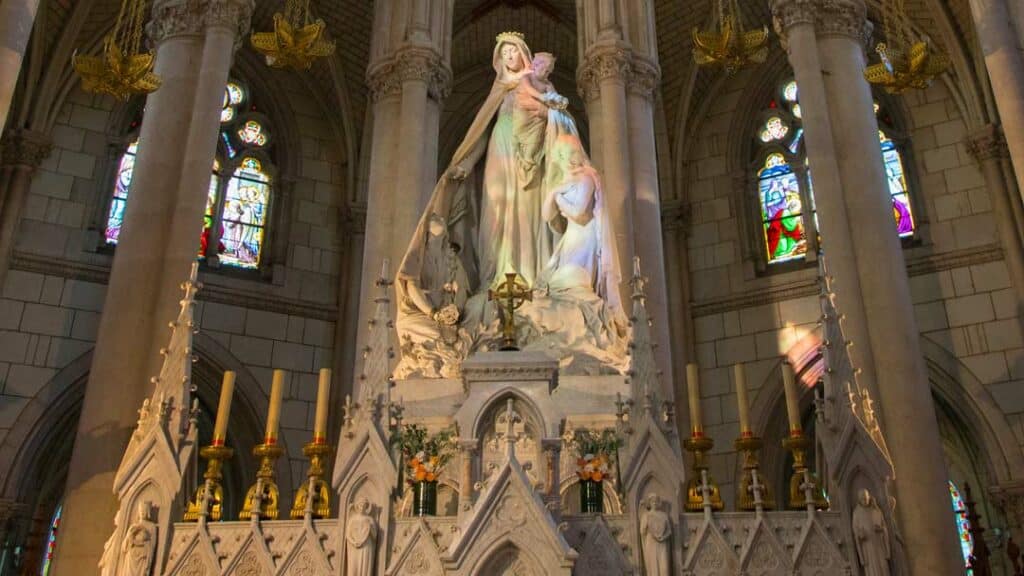At the Shrine Notre-Dame de Montligeon, Mary is prayed under the title
“Our Lady Liberator”. What does it mean though? Sister Cécile, prioress of the Nouvelle Alliance community, shares her meditation before the statue of Mary, towering above the choir in the church. She sees in her a mother who welcomes, comforts, intercedes and, in particular, leads the souls to her son.
This interview was made for the program “Les sanctuaires normands” of RCF Orne-Calvados-Manche, broadcast on Tuesdays at 19h15.
Mary greets the pilgrims
Every year, on the eve before the Assumption day, the pilgrims of Montligeon take part in a torchlight procession. This is a deeply symbolical moment, when the participants walk down through the village and back to the basilica. Sister Cécile, the prioress of the Nouvelle Alliance community, keeps a strong memory of it. “Each year, I am very touched by this procession. We start at the foot of the statue of St Joseph, which is at the lowest point down the basilica. Then we walk up all the alleyway towards the church.”
This ascending movement is not just geographical. It mean an inner elevation. “It is a symbol for our lives, we are called to move from this earth to heaven, towards eternity.” The faithful walk in the dark, holding a light and surrounded by darkness. Before them, the gates of the basilica open. Over there, in the light, the statue of Mary comes into view.
“There is a perspective effect. When you stand at the foot of the statue of Saint Joseph, it looks like Mary stands flush with the front gates of the basilica. There she is, welcoming us.”
Mary, a gateway to heaven
In that procession towards the basilica, it is as if Mary was telling us: “I am the one welcoming you, get into my Son’s house.” This very powerful sight alone – a mother standing at the entrance of the house, in the light, in the middle of the night – sums up the spiritual insight on the shrine. Mary is more than just present. She stands there, in the light, waiting. She draws our attention. She joins us on the way. She is watchful, waiting for each one on a personal level. Clearly, the title “Mary Liberator” is rooted in this welcoming attitude. She is a mother who liberates the souls from what holds them back: fear, pain, solitude, even despair sometimes.

“Behold your mother. ”
(Jn 19, 27)
In Montligeon, the figure of Mary is central in the space. You see her first as soon as you step into the basilica. “In a number of churches, you have a great cross, a tall crucifix which catches your attention in the first place. Here, you don’t have that. What you see is Mary’s statue, towering over the high-altar and the tabernacle.”
Of course, Jesus is present indeed, in the Holy Sacrament. A small red light discretely points to it. However, this very discretion is meaningful. “There is a disproportion. Mary majestically overlooks him, as if Jesus meant to keep small and discreet, for those who go through their ordeal.”
Sister Cécile thinks this can be seen as an expression of thoughtfulness, deliberately chosen by Christ. “He said to us: ‘Behold your mother’. He gave her to us on the cross.” In fact, when we are faced with hardships, when our faith waivers, when questions arise or even when anger fills our heart, Mary comes to us. “Jesus seems to withdraw in order for her to step forward and join us, in order to take us back to him.”
Mary, Comforter of the Afflicted
In Montligeon, Mary’s mission unfolds in two directions: she intercedes for the deceased ant comforts the living as well. “Yes, that’s her mission”, confirms Sister Cécile, “a powerful intercession for the souls in purgatory. As she explains, those souls can no longer do anything for themselves. “The only thing they can do is to desire. Their desire is to love with God’s own love. Yet they can no longer perform meritorious actions.”
For this reason, intercession is essential, Mary’s intercession in the first place. But the intercession from the living is just as important. “We can offer our prayers. We can pray Mary for those who have left us.” In her role as a mediator, Mary behaves lovingly. She is a mother, a presence, a support. “Mary, Comforter of the Afflicted”, as the litany goes. Moreover, she is also called “Star of the Sea”, a title familiar to sailors. For those in mourning, it is particularly meaningful. “When you experience bereavement, everything becomes dark. The colors are lost. Hope itself struggles to find its way in our heart.” That’s when Mary emerges.
“She is that star in the pitch black sky. Like the morning star pointing to the North, she looks like the star for the sailor on a stormy sea.” In the inner turmoil of bereavement, she plays the same part. Sr Cécile goes on: “Bereavement is an obstacle course. There are steps, deep shocks, an inner stormy sea.”
At that point, Saint Bernard’s words come back to our minds : ‘If you follow her, you will not get lost, she will lead you to the harbor.” As Sr Cécile reminds us, “this harbor is eternal life”. In Montligeon, Mary is far more than a symbol. She is a “mother of hope” for all those who suffer, those who go through an ordeal, those who can hardly believe that there is still a future for them.
Mary, liberator of the souls
For those who do not know Notre-Dame de Montligeon, you should take a moment to gaze at the tall statue overlooking the high-altar in the basilica. It is huge and majestic. Mary stands imposingly, holding the child Jesus in her arms. However, this Jesus does not all look like a formidable judge. “Mary presents him to us like a small child or toddler. She gives him to us in innocence.”
Sitting at her feet, two characters draw our attention. They look like two women, however they represent the same soul, seen at two different times of her journey. “On the right, you can see a soul still needing purification. It is tied with chains, the ties of her earthly attachments. Her love is still too focused on herself.” She gazes up at Mary with her arms extended in silent plea. Mary, gently waving with her right hand, leans towards her: “Come, I am looking after you.”
On the left, the soul has been changed. She sits on a little cloud, and her clothes impart her more dignity. The Child Jesus himself crowns her with a flower wreath. “This is very beautiful because this soul is the one that has arrived in heaven. And also, Jesus does not judge her: he crowns her.” This welcoming gesture matches the words in Psalm 103 : « He crowns you with loving kindness and pity. »
As this scene is taking place, Mary is not looking at the soul that has already reached the goal. Her gaze dwells on the one that is still struggling, waiting and hoping. “She looks at her lovingly, extending her hand towards her.” This extended hand sums up the whole message of Montligeon: Mary is the Liberator. She does not keep anything for herself. She introduces the souls in the light. She takes them where they are, to guide them further.
Historically, this representation could have been inspired by that of Notre-Dame de la Merci, the former figure of Mary Liberator of captives. “Father Paul Buguet, founder of the shrine, wanted a Marian basilica. He probably drew from this iconography.” At Montligeon, Mary comes to fetch the souls in purgatory. She doesn’t abandon them to their fate. She intercedes. She liberates.


“Pray for us, now and at the hour of our death”.
At the heart of prayer for the dead at Montligeon are the “pilgrimages from Heaven”. In November, crowds gather here in a simple, sober, deeply authentic fervor. “You really have to come and see what it’s like, says Sister Cécile, in order really get an idea of the fervor infusing the pilgrims. The simplicity of their prayer is perhaps one that we, Westerners, have lost.
In those crowds from Africa and elsewhere, Mary is invoked like a mother. They sing to her, they pray to her, they abandon themselves to her. “It’s also a crowd that carries us in prayer. It makes you more aware of the communion of the Church, of the communion of saints. And all are focused on the same goal: eternity, through Mary.”
Then Mary is more that a queen. She becomes a sister. A sister in ordeal, a sister in grief. “She was acquainted with the experience of losing a child. She stood at the foot of the Cross. Her heart was shattered and pierced by a sword.” Yet she did not waiver. She stood firm in faith and hope.
“She is the woman of Holy Saturday. When all are afraid, when all feel down, she remains hopeful.” For Sister Cécile, Mary is like a rock. “We can lean on her faith, on her hope. And even if you feel poor, unable to believe, Mary remains there. She is this immense figure, but also this mother on her knees, very close to those who suffer.
At Cana, she was already interceding discreetly. She saw what no one else saw. She said: “Do whatever he tells you. This Gospel indeed is read on the day celebrating Our Lady of Suffrage, Our Lady Liberator. At each Hail Mary, we say: “Pray for us now and at the hour of our death.”
In particular, Sister Cécile is thinking of those personally impacted by stories of violent death, misunderstanding or suicide. “Even if I wasn’t present at the time of death, it’s not too late. In God’s time, everything is still possible. Mary was there. And it was she who, in my name, accomplished what I couldn’t.”
Mary acts discreetly, over a long period of time. She does it through simple things, like a whispered prayer, a peaceful presence. “I’m thinking of someone I’m supporting who was very angry with a deceased person. I offered her a very simple prayer to Mary: ‘Lay your hand on my forehead, stop my thoughts.’ And that changed something.”
“Marie is truly a mother at our side. She is Our Lady of Montligeon.”
Praying with the Montligeon Fraternity
At Montligeon, Mary, Liberator, welcomes the living and the dead. She intercedes, consoles and stands at your side. By joining the Fraternité de Montligeon, you can entrust your deceased to her prayers, and enter this great communion of hope.




